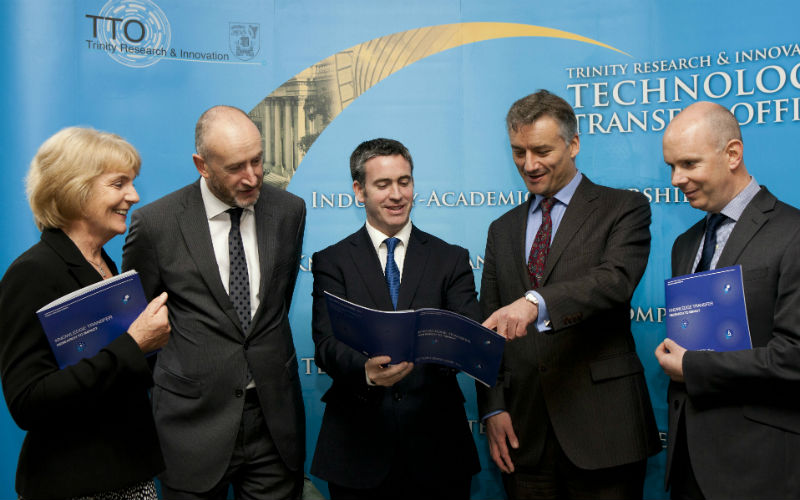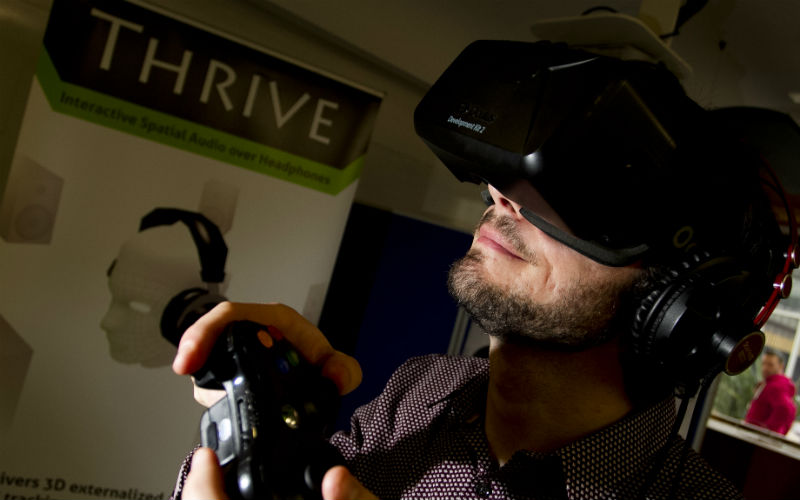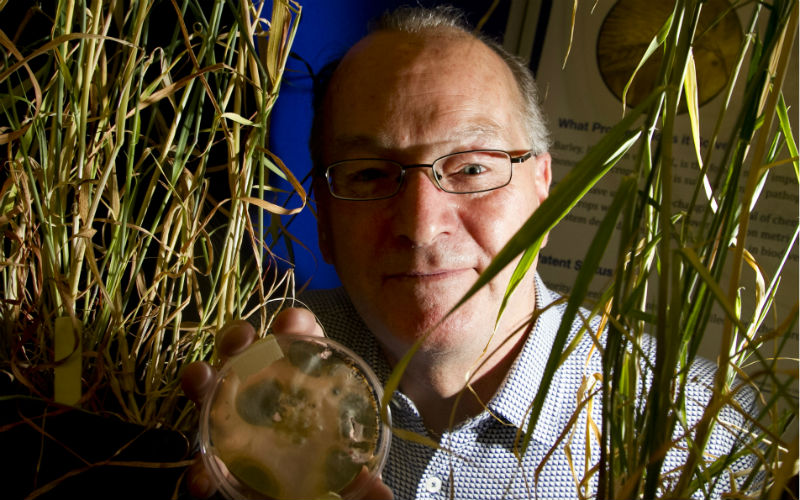Trinity Showcases 500 Inventions from Protecting Neurons to Protecting Earth from Space Debris
Posted on: 16 October 2014
Trinity College Dublin this week marked its 500th invention disclosure at a special event showcasing the impact of some key inventions and the potential of our latest invention technologies, in the O’Reilly Institute. The showcase event was opened by Minister for Skills, Research and Innovation, Damien English.
Since the first invention disclosure forms were filed Trinity has translated 500 inventions into the creation of 42 campus companies and the licensing of 126 technologies to industry. An invention disclosure is the first step in formally translating research to create economic and, or societal impact.
The 42 new campus companies operate in areas as diverse as new software for gaming companies, new therapeutics for anti-inflammatory diseases and medical device companies which have developed novel technologies for simulating blood flow in the body. Of the 126 licenses which have been granted, more than 80% of them have been awarded to Irish based companies.

The Impact Showcase highlighted some of the new technologies emerging from Trinity currently available for licensing, including the 500th invention disclosure.
Charting Trinity’s history of inventions to the present day, they range from a treatment protecting the body’s neurons, to the globally transformative nicotine patch to the landmark 500th invention disclosure that protects the earth from space debris. This cutting edge 21st century technology is designed to help protect the earth and its inhabitants from the falling debris of disintegrating spacecraft and satellites that re-enter the earth’s atmosphere. Currently being tested in collaboration with the European Space Agency, it provides accurate predictions for spacecraft, satellite and space station parts on their re-entry into the atmosphere.

They also include an immersive audio-visual technology (THRIVE) that goes beyond the capabilities of normal 3D audio technologies by recreating an ultra-realistic soundfield that includes height and depth; novel vaccine components that have considerable potential for the development of a more effective vaccine against whooping cough, which affects an estimated 16 million children worldwide; and a potentially eco-friendly, cost effective, sustainable alternative to the existing cycle of annual fungicidal and fertiliser crop treatments used on barley crops worldwide.
Commenting on the significance of the University’s latest invention disclosure technologies, Minister for Skills, Research and Innovation, Damien English TD said: “The Government is committed to accelerating the economic and societal return on our Science, Technology and Innovation investment, further strengthening enterprise engagement with public research and driving more commercialisation of publicly-performed research. Trinity College has a strong tradition of innovation and successful commercialisation and its research community continues to partner with industry creating new breakthrough technologies”. He added: “The focus on entrepreneurship within Trinity is enabling Ireland's innovation society and the creation of high-quality jobs that will last. This current pipeline of emerging technologies from Trinity constitutes a significant contribution to the continuation of Ireland’s economic recovery.”
“Trinity is committed to research excellence and translating this excellence to achieve economic and societal impact. This showcase highlights how Trinity researchers have changed Ireland, and the broader world, through the licensing of technologies, the creation of new companies and the establishment of partnerships with industry.” said Dr Diarmuid O'Brien, Director of Trinity Research and Innovation.
Trinity's Dean of Research, Professor Vinny Cahill, concluded: "Trinity is at the heart of an ecosystem that is helping to position Ireland as the vanguard of innovation. We are committed to matching disruptive ideas with smart business models and the successes and new technologies being showcased demonstrate the impacts already generated by this approach and also the future possibilities for delivering economic, cultural and social value founded on research and scholarship.”
As part of Trinity's recently launched Strategy for Innovation and Entrepreneurship which is embedding innovation and entrepreneurship throughout the university, Trinity Research and Innovation also opened a new Office of Corporate Partnership and Knowledge Exchange. The OCPKE provides a one-stop shop for industry engagement on the campus. It combines – unlike any other university in Ireland – all of the offices required to support the establishment of a collaborative programme with industry. Trinity's offices of research, contract, technology transfer, and industry engagement, as well as entrepreneurship supports, sit in the new OCPKE.
Case Study 1 – The 500th Invention Disclosure from Trinity:
A Risk Assessment Tool for Spacecraft Re-entry
Professor of Statistics, Simon Wilson and Cristina De Persis, School of Computer Science and Statistics.
The 500th invention disclosure generated by Trinity is an innovative tool designed to help protect earth and its inhabitants from the falling debris of defunct and disintegrating spacecraft and satellites that eventually re-enter the earth’s atmosphere.
Currently, the United Space Surveillance Network is tracking more than 16,000 objects orbiting Earth, about 87 percent of which are debris or inactive satellites. Any satellite orbiting the Earth will eventually, over time, begin to renter the atmosphere and parts of these may survive re-entry and hit the earth’s surface.
Trinity researchers from the School of Computer Science & Statistics, Professor of Statistics, Simon Wilson and Cristina De Persis have developed a risk assessment tool for spacecraft re-entry, in collaboration with the European Space Agency (ESA). The tool is now being filed with the European Patent Office to become Trinity's 500th patent. The invention is directed towards providing improved accuracy of modelling to achieve more accurate predictions for any given space vehicle (spacecraft, satellite, space station) on re-entry into the atmosphere.
Case Study 2 – THRIVE Immersive Audio on Oculus Rift
Professor of Engineering Science, Frank Boland, School of Engineering.
THRIVE is a headphone audio system that unlike other 3D audio technologies, actually recreates an ultra-realistic sound field, including height and depth, at the listeners’ ears. THRIVE delivers highly realistic, dynamic and very efficient sound fields which react in real-time to a listener’s movements providing the most realistic virtual reality experience.
Thrive Audio has been developed by a group of research engineers from the School of Engineering in Trinity who live and breathe 3D virtual audio environments. Their technology, on which two patent applications were recently filed, stems from almost a decade of internationally acknowledged research into spatial audio.
The team uses the head tracking features of Oculus Rift, the virtual reality head mounted display for 3D gaming, to inform their sound field reproduction. This intrinsically links both technologies and complements the Oculus Rift creating a truly immersive audio-visual experience for the user.

Case Study 3:
Drop/Bubble Surface tension measurement
Assistant Professor in Mechanical and Manufacturing Engineering, Tony Robinson.
Assistant Professor Tony Robinson from the School of Engineering and Postdoctoral Fellow Dr Samuel Siedel have developed a simplified, low cost, instantaneous measurement technique for calculating the surface tension of a drop or bubble with simple linear measurements, without compromising the measurement accuracy.
Knowing the surface tension of a fluid can be very important for those working in the food, chemical, oil, pharmaceutical, biological and engineering industries. Surface tension measurements on drops or bubbles can reveal, for example, the quality of the fluid or the level of contamination in it. These measurements can be used in an industrial environment, for example, to monitor the detergent concentration in an industrial cleaning process, or for monitoring product quality to help identify and eliminate contamination. From a product development perspective it can be used to help design and develop surface coatings such as on self-cleaning glass windows so that water beading can be investigated and optimised.
Normally, surface tension measurements are calculated through a time consuming technique whereby a complex mathematical equation is solved thousands of times and ‘best fit’ to an image of a static liquid drop. These systems are complex, expensive and not portable.
It is hoped that this new technology will open up a new market for fast acquisition, lower cost surface tension measurement machines.
Case Study 4
Fungal Root Endophytes – benefiting cereal crop yield and performance.
Associate Professor in Botany, Dr Trevor Hodkinson, Brian Murphy School of Natural Sciences and Fiona Doohan, UCD.
Barley is the fourth most important global cereal crop, grown annually on 48 million hectares. Like most important monoculture crops, barley is subject to many infections which cause significant economic losses running into the hundreds of millions for individual countries.
Growers use an ever-changing arsenal of chemicals in an effort to control these infections and maintain yield, which, as well as the economic cost can also have major environmental costs for ecosystems and potential losses in biodiversity.
Researchers Brian Murphy and Dr Trevor Hodkinson, from the School of Natural Sciences & Trinity Centre for Biodiversity Research, in collaboration with Fiona Doohan of UCD, have developed a potentially eco-friendly, cost effective, sustainable alternative to the existing never-ending cycle of annual fungicidal and fertiliser crop treatments.
Their research focusses on endophytes which are microorganisms (such as bacteria or fungi) which can live at least part of their life cycle inside of plants, usually without inducing infectious symptoms. The team has shown that inoculation with a new species of fungal root endophytes from wild populations of barley species, significantly increased grain yield and dry shoot weight in nutrient-starved barley, and also suppressed the development of barley infections.

Case Study 5 – Novel Vaccine Components for Whooping cough
Professor of Experimental Immunology, Kingston Mills and Assistant Professor in Molecular Immunology, Dr Aisling Dunne.
Ireland’s Laboratory Scientist of the Year (2013) Professor Kingston Mills and Dr Dunne from the School of Biochemistry and Immunology, have recently filed a priority patent with the European Patent Office for discovered novel lipoproteins that may be used to develop a potentially more effective vaccine against whooping cough, which may eventually help to control the re-emergence of this infectious disease.
Following concerns over side effects, the original whooping cough vaccination was replaced in the 1990s by a new vaccine made from components of the whooping cough bacteria (Bordetella pertussis) combined with an adjuvant to boost immune responses. This vaccine has proved to be very safe and has been effective in controlling the potentially fatal disease of whooping cough in children.
It appears protective immunity conferred with the vaccine falls quite quickly, necessitating frequent booster vaccinations. This fall off in the immunity may be contributing to the increasing number of whooping cough cases.
Professor Mills’ and Dr Dunne’s discoveries of new ‘TLR2 agonists’ which are derived from Bordetella pertussis have considerable potential for the development of a more effective vaccine capable of generating protective cellular immunity against the re-emerging B. pertussis pathogen and other conditions such as cancer or allergic diseases. Using these ‘TLR2 agonists’ in a vaccine also has the potential to protect a higher proportion of immunised children using a lower number of doses.
Trinity has recently filed a priority patent application with the European Patent Office to protect the intellectual property encompassed in the technology.
